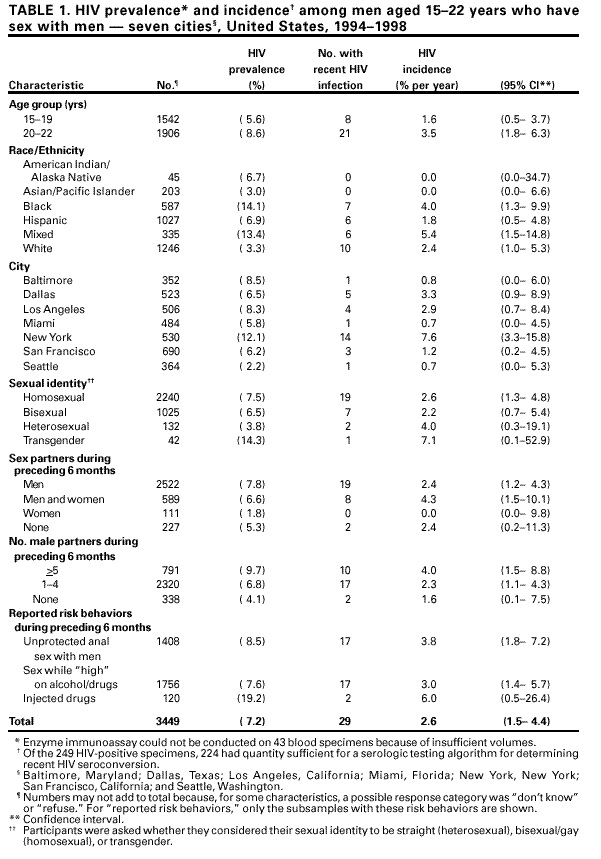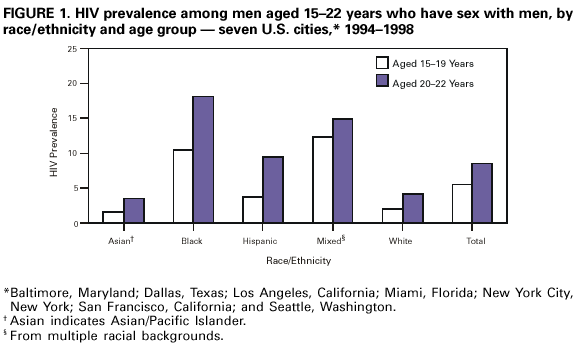 |
|
|
|
|
|
|
|
|
|
|
|
|
|
|
|
|
||||
| ||||||||||
|
|
|
|
|
“HIV Incidence Among Young Men Who Have Sex With Men --- Seven U.S. Cities, 1994--2000” Real Player G2 HIV Incidence Among Young Men Who Have Sex With Men --- Seven U.S. Cities, 1994--2000Twenty years after the first report on human immunodeficiency virus (HIV) infection in the United States, studies of sexually transmitted diseases (STDs) and sexual behaviors suggest a resurgent HIV epidemic among men who have sex with men (MSM) (1,2). However, few recent studies have measured HIV incidence in this population (3--7). To determine HIV incidence among young MSM, CDC analyzed data from the Young Men's Survey (YMS), a study that found a high prevalence of HIV and associated risks among MSM aged 15--22 years sampled in seven U.S. cities (8). This report confirms high HIV incidence among these young men. YMS Phase I was a cross-sectional, multisite, venue-based sample survey of men aged 15--22 years who attended public venues where young MSM congregate (e.g., urban shopping blocks, dance clubs, bars, and young gay organizations) (8). During the survey start-up in each city, formative research was conducted to identify all venues frequented by young MSM, and the days and times when young men frequented these venues. A three-stage sampling plan was used to randomly select venues from the sampling frame of venues and then to randomly select times. Sampled venues and times were then scheduled for the third stage of sampling in which young men were sampled at 194 venues in Baltimore, Maryland; Dallas, Texas; Los Angeles, California; Miami, Florida; New York, New York; San Francisco, California; and Seattle, Washington. Eligible men (i.e., local residents aged 15--22 years) were recruited for the survey. Participants were asked about their risk behaviors and demographics, and counseled about and tested for HIV; blood specimens were tested anonymously for HIV. Participants were scheduled to return in 2 weeks for test results, posttest counseling, and service referrals. Duplicate enrollees were removed from the database by various screening methods, including the Miragen Assay, which profiles antibodies. Because no association was found between frequency of venue attendance and HIV prevalence, the data were not weighted according to venue attendance. An enzyme immunoassay was used to screen blood specimens for HIV antibody. Repeatedly reactive specimens were confirmed by Western blot or indirect immunofluorescence. To estimate HIV incidence, a serologic testing algorithm was used to determine recent HIV seroconversion (STARHS) (9). HIV-positive specimens were tested with a sensitive HIV-1 whole viral lysate EIA (3A11) (Abbott, Abbott Park, Illinois) that detects infection approximately 30 days after transmission. Specimens that were 3A11-reactive were retested using the 3A11-LS (less-sensitive), which detects HIV infection approximately 140 days after the 3A11 (95% confidence interval [CI]=125--156 days). A specimen that was 3A11-reactive but 3A11-LS-nonreactive was categorized as a recent infection. Incidence was calculated using the number of persons with recent infections as the numerator and the number of persons with recent infections plus the number of persons who were HIV-negative as the denominator. Incidence estimates were adjusted for HIV-positive specimens that were not tested by STARHS. Incidence was annualized to units of percent per year. All data were analyzed using SAS version 6.12. In the seven cities, 3492 young MSM enrolled (range for the seven cities: 357--702 MSM) (8). The enrollment rate was 62% (range: 51%--75%). The prevalence of HIV infection was 7.2% (range: 2.2%--12.1%), increased with age, and was higher among blacks, Hispanics, and men of mixed race than among whites or Asians/Pacific Islanders (Figure 1). These findings and the high prevalence of unprotected anal sex during the preceding 6 months (41%; range: 33%--49%) suggested that HIV incidence was high among these young men. Of the 3449 young MSM tested, 249 were HIV-positive. Of the 249 HIV-positive specimens, 224 were tested by STARHS; 29 met the criteria for recent infection (Table 1). HIV incidence was 2.6% overall, 3.5% among persons aged 20--22 years, 4.0% among blacks, and 5.4% among men of mixed race. Of the 29 persons with recent infections, 14 were from New York City. HIV incidence was similar among homosexual and bisexual men. Recent risk behaviors associated with high HIV incidence were having >5 male sex partners during the preceding 6 months, having unprotected anal sex with men, or having injected drugs. During 1998--2000, YMS Phase II was conducted to sample MSM aged 23--29 years in six of the seven cities (excluding San Francisco). Data are preliminary. Of the 2942 young MSM, 1409 (48%) were white, 651 (22%) were Hispanic, and 497 (17%) were black. Of these, 373 (13%) were HIV-positive; HIV prevalence was 7% among whites, 14% among Hispanics, and 32% among blacks. Of the 373 HIV-positive specimens, 290 were STARHS-tested; 38 were recent infections. Overall incidence was 4.4% (95% CI=2.9%--6.7%); HIV incidence was 2.5% among whites (95% CI=1.4%--4.6%), 3.5% among Hispanics (95% CI=1.4%--8.6%), and 14.7% among blacks (95% CI=7.9%--27.1%). Reported by: W McFarland, MD, MH Katz, MD, San Francisco Dept of Public Health, San Francisco; SR Stoyanoff, MPH, Los Angeles County Dept of Health Svcs, Los Angeles, California. DA Shehan, Univ of Texas Southwestern Medical Center at Dallas, Dallas, Texas. M LaLota, MPH, Florida Dept of Health. DD Celentano, ScD, Johns Hopkins Univ School of Hygiene and Public Health, Baltimore, Maryland. BA Koblin, PhD, New York Blood Center, LV Torian, PhD, New York City Dept of Health, New York, New York. H Thiede, DVM, Public Health--Seattle and King County, Seattle, Washington. Clinical Biochemistry Br, Div of Environmental Health Laboratory Sciences, National Center for Environmental Health; Prevention Svcs Research Br, Statistics and Data Management Br, Office of the Director, Div of HIV/AIDS Prevention--Surveillance and Epidemiology, National Center for HIV, STD, and TB Prevention, CDC. Editorial Note: The findings in this report document a high incidence of HIV among a sample of young MSM, particularly blacks in their 20s. The overall incidence was comparable to that reported in recent studies of adult MSM (3--7). In the 20th year of the HIV epidemic, young MSM in these cities continue to be at high risk for HIV infection. This is the first published report using STARHS to provide incidence estimates in community-recruited sample surveys. In this study, HIV incidence was high among MSM in their 20s and young racial/ethnic minority MSM, especially blacks. Because there were no earlier incidence studies of MSM aged 15--22 years, it is unknown whether HIV transmission among very young MSM is increasing. However, the preliminary high incidence data among MSM aged 23--29 years in YMS Phase II, in conjunction with other recent findings on STDs and sexual behaviors (1,2), are of concern and may suggest a resurgent MSM epidemic among young MSM in the late 1990s. The findings in this report are subject to at least three limitations. First, although enrollment rates were high, sampling was conducted through outreach at venues, and it is not known whether young men with recent high-risk behaviors were more likely to enroll. Second, young men were sampled only at randomly selected venues, and incidence may have been lower if young MSM who did not go to venues or did not live in cities had been sampled. Third, data for YMS Phase II are preliminary, particularly because not all specimens were STARHS-tested and the final results may change slightly. Young MSM need to be targeted with early and sustained prevention efforts specifically tailored to their needs. In a recent health bulletin sent to HIV prevention providers, CDC encouraged local areas to assess their current situation and services and, if necessary, develop new prevention messages, improve the quality of STD clinical services for MSM, expand prevention and outreach for HIV-positive MSM, and address the factors that may be contributing to high incidence such as the impact of racism and homophobia on risk behavior (10). The high HIV incidence described in this report calls for a vigorous public health and community response to prevent HIV. References
Table 1  Return to top. Figure 1  Return to top. Disclaimer All MMWR HTML versions of articles are electronic conversions from ASCII text into HTML. This conversion may have resulted in character translation or format errors in the HTML version. Users should not rely on this HTML document, but are referred to the electronic PDF version and/or the original MMWR paper copy for the official text, figures, and tables. An original paper copy of this issue can be obtained from the Superintendent of Documents, U.S. Government Printing Office (GPO), Washington, DC 20402-9371; telephone: (202) 512-1800. Contact GPO for current prices. **Questions or messages regarding errors in formatting should be addressed to mmwrq@cdc.gov.Page converted: 6/8/2001 |
|||||||||
This page last reviewed 6/8/2001
|